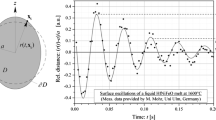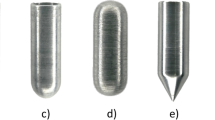Abstract
A new type of viscometer, the “Falling Needle Viscometer” (FNV) has been developed. It has several advantages over the better known “Falling Ball Viscometer” (FBV) including better control over the trajectory and terminal velocity and a “wall correction” which is an integral part of the analytical solution.
A Stokes' type solution for the FNV is presented which is compared with experimental measurements made on Glycerol. Experiments were also conducted with a Falling Ball Viscometer and Weissenberg Rheogoniometer using the same fluid and a comparison made among the three systems.
Glycerol viscosities measured with the FNV agreed with those measured by the FBV and Weissenberg Rheogoniometer within approximately one percent. It is concluded that the Falling Needle Viscometer is a useful device that in some situations is superior to the Falling Ball Viscometer.
Zusammenfassung
Es wurde ein neues Gerät zur Zähigkeitsmessung, as Nadelfall-Viskosimeter (FNV) entwickelt. Gegenüber dem bekannteren Kugelfall-Viskosimeter (FBV) besitzt es einige Vorteile wie eine bessere Kontrolle über die Bahnkurve und die Endgeschwindigkeit sowie eine „Wandkorrektur“, die Bestandteil der analytischen Lösung ist.
Für das FNV wird eine Lösung vom Stokes'schen Typ vorgestellt und mit experimentellen Meßergebnissen an Glycerin verglichen. Meßwerte am selben Fluid mit Hilfe eines FBV und eines Weissenberg-Rheogoniometers erlaubten einen Vergleich zwischen den drei Systemen.
Die mit dem FNV gemessenen Zähigkeiten stimmten mit den anderen Werten innerhalb etwa 1% überein. Daraus wird geschlossen, daß das FNV ein nützliches Gerät ist, das dem FBV auf einigen Gebieten überlegen ist.
Similar content being viewed by others
Abbreviations
- a :
-
Radius of needle or sphere (cm)
- b :
-
Radius of container (cm)
- b + :
-
Ratio of container to needle diameterb/a
- C w :
-
Wall correction factor of sphere
- d :
-
Diameter of needle or sphere (cm)
- ECF :
-
End correction factor of a finite needle with hemisphere tips
- g :
-
Gravitational constant
- G + :
-
Dimensionless number\(\left( {\frac{{b^{ + 2} (Inb^ + - 1) + Inb^ + + 1}}{{b^{ + 2} + 1}}} \right)\)
- L :
-
Total needle length minus one diameter (cm)
- L′ :
-
Total length of needle (cm)
- L + :
-
Total needle length minus one diameter over diameter-L/d
- L+′ :
-
Total length to diameter of needle
- p :
-
Pressure (N/m2)
- p + :
-
Dimensionless number\(\left( {\frac{{\Delta pa^2 }}{{2\mu LU_\infty }}} \right)\)
- L +′/b + :
-
Total needle length to diameter of system
- r :
-
Radial coordinate (cm)
- r + :
-
Dimensionless radial distance(r/a)
- Re :
-
Reynolds number\(\left( {\frac{{dU_\infty }}{v}} \right)\) or\(\frac{{2(b - a)U_\infty }}{{v(b^{ + 2} - 1)}}\)
- u :
-
Velocity in the system length direction (cm/s)
- u + :
-
Dimensionless velocity (u/U ∞)
- U t :
-
Measured terminal velocity of needle or sphere (cm/s)
- U ∞ :
-
Terminal velocity of sphere in an unbounded fluid or terminal velocity of a long enough needle (cm/s)
- U +∞ :
-
Dimensionless number\(\left( {\frac{{\mu U_\infty }}{{\varrho _f gd^2 }}} \right)\)
- T :
-
Temperature (°C)
- z :
-
Coordinate in container length direction (cm)
- \(\dot \gamma \) :
-
Shear rate (l/s)
- Δp :
-
Pressure difference
- μ :
-
Dynamic viscosity (Ns/m2)
- ν :
-
Kinematic viscosity (m2/s)
- ϱ f :
-
Density of fluid (kg/m3)
- ϱ s :
-
Density of needle or sphere (kg/m3)
- ϱ + :
-
Dimensionless density\(\left( {\frac{{\varrho _s - \varrho _f }}{{\varrho _f }}} \right)\)
References
Smith, G. S.: Plunger rheometer — Law of flow for Newtonian liquid. J. Inst. Pet. 43 (1957) 227
Lohrenz, J.; Swift, G. W.; Kurata, F.: An experimentally verified theoretical study of the falling cylinder viscometer. AI.Ch.E. Journal 6 (1960) 547
Park, N. A: M.S. thesis, studies on the falling ball and falling needle viscometers, Mechanical Engineering Dept., State University of New York at Stony Brook 1982
Faxen, H.: Die Bewegung einer starren Kugel längs der Achse eines mit zäher Flüssigkeit gefüllten Rohres. Ark. Matematik Astron. Fys. 17 (1923) 1
Kwack, Y. E.; Hartnett, J. P.: Personal Communication, June 1981
Cho, Y. I.: Ph.D. Thesis, The Study of Non-Newtonian flows in the falling ball viscometer, Univ. Illinois 1979
Author information
Authors and Affiliations
Additional information
Dedicated to Professor E. R. G. Eckert on the occasion of his 80th birthday
Rights and permissions
About this article
Cite this article
Park, N.A., Irvine, T.F. The falling needle viscometer a new technique for viscosity measurements. Wärme- und Stoffübertragung 18, 201–206 (1984). https://doi.org/10.1007/BF01007130
Received:
Issue Date:
DOI: https://doi.org/10.1007/BF01007130




